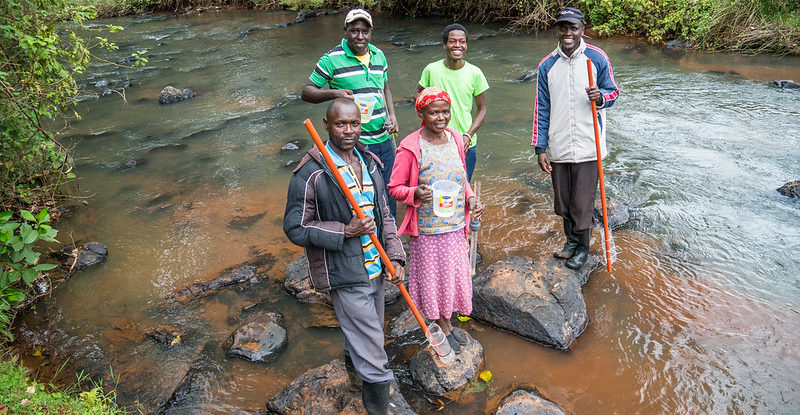
In the Sondu-Miriu river basin in Western Kenya, locals are sometimes seen pulling out their cellphones as they pass water gauges along the river, reading the numbers on the gauge and sending off text messages.
They are volunteers in a citizen science project, founded in 2016, to monitor water levels in the basin. The Sondu-Miriu has its headwaters in the Mau Forest Complex and contributes water to Lake Victoria and the river Nile, as well as supporting the lives and livelihoods of the people who live along its breadth.
Climate change, deforestation and land-use change are affecting the quality, quantity and reliability of the basin river’s flow. But as in many parts of the developing world, efforts to manage the basin’s water more effectively are stymied by, among other things, a dearth of data – and a lack of funds and infrastructure to collect that information in conventional ways.
That is where the citizen scientists come in. Citizen science – in which volunteers from the general public contribute to science projects, usually by collecting or analyzing data – is gaining popularity across the globe, particularly as a means of collecting environmental information.
But crowd-sourced data is only as good as the “crowd” it comes from, so knowing what encourages people to participate, what demographics tend to be most committed and motivated, and what gets in the way of engagement, is crucial for successful project design.
In that context, a new study by scientists at Germany’s Justus Liebig University Giessen (JLU), Kenya’s University of Kabianga, Britain’s Lancaster Environment Centre and the Center for International Forestry Research (CIFOR), explores which kinds of Sondu-Miriu residents tend to put up their hands to collect water data, and what inspires them to get – and stay – involved in the process.
The researchers conducted a phone survey of 90 people who had submitted data to the project, and found that people in the 30 to 49 year age group, with a primary level of education and who lived close to the monitoring stations, were the most active. This differs somewhat from participation patterns in more developed countries, where active volunteers tend to be older and more educated, but is perhaps unsurprising in this context, as higher-educated people are more likely to migrate to urban areas where there are more career opportunities.
The data also showed that most people’s motivations for involvement were centered on environmental awareness and concern. “These people recognized that water is an important resource, and they had perceived environmental changes and shifts in water flow in the area over the last few years,” said Björn Weeser, project manager of the SDGnexus Network at JLU and the lead author of the study.
The researchers found that the majority of data was submitted using regular (non-“smart”) cellphones, which confirmed the appropriateness of using a SMS text-message-based system, rather than an app or website. However, a lack of cellphone credit to send those texts was identified as a key barrier for many participants, so future projects would ideally involve a toll-free number to which people could text the information, said Weeser.
In parts of the basin where the Water Resources Authority previously paid a local community member to record water levels in a governmental monitoring program it was also more difficult to motivate ongoing involvement. “Understandably, people were asking: ‘if this person used to be paid for it, why are we not getting paid?’” said Weeser. “So if such a system has been in place in the past, it can be difficult to then implement something on a voluntary basis.”
Another barrier to ongoing involvement was a lack of tangible results and ongoing communication about the work’s significance. “I do think that people were expecting a little bit more from it,” said Suzanne Jacobs, a researcher at JLU and a co-author of the study; “to see something changing through their participation, or even just to understand what was being done with the data. Because after a while, the interactions between the researchers, the water resource authority and the community on the ground began to reduce, and that was one of the reasons why people stopped participating.”
Taking these challenges into account, Weeser and Jacobs believe that the method used in the project has great potential to be applied more effectively within the basin – and applied to other contexts, too. “It’s straightforward, low-cost and easy to implement,” said Weeser, “and very interesting for less-developed countries – especially because it doesn’t require the use of smartphones.”
Projects like these can also help local communities to advocate for resource management changes, said Jacobs. “When people observe changes in the resource through the data they’re collecting, they can actually step up and say ‘hey, we’re seeing this, and this is the evidence we have: please do something about it,” she said.
And the need for the kind of data these projects are collecting is ever-more pressing. “Hydrology is really lacking data, and without this you cannot fully assess climate-change impacts on the ground – and remote-sensing is not yet small-scale enough for this kind of question,” said Weeser.
“And it’s not just about climate change, it’s about water management in general,” said Jacobs. “There are a lot of people competing for water uses. Water allocation plans, for example, are really essential to make sure that everyone along the transect, from the headwaters to wherever the river is going, has access to sufficient water – and data really helps to do this properly.”
We want you to share Forests News content, which is licensed under Creative Commons Attribution-NonCommercial-ShareAlike 4.0 International (CC BY-NC-SA 4.0). This means you are free to redistribute our material for non-commercial purposes. All we ask is that you give Forests News appropriate credit and link to the original Forests News content, indicate if changes were made, and distribute your contributions under the same Creative Commons license. You must notify Forests News if you repost, reprint or reuse our materials by contacting forestsnews@cifor-icraf.org.